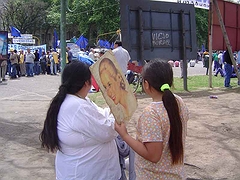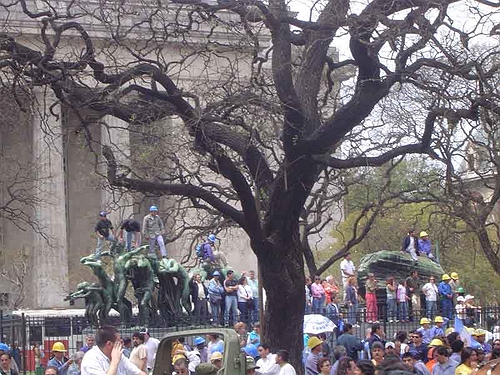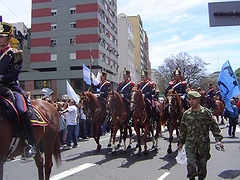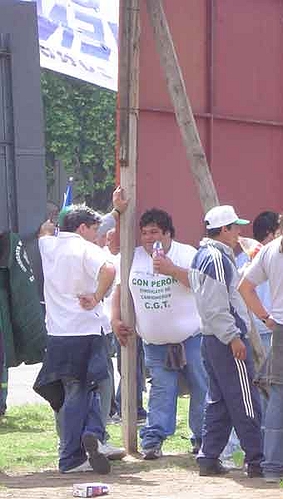Augunga, Kisama, Maravi, Monyolo, Mina Nagó, Sabalu … these were some of the names of the more than fifty African “nations” that existed in Buenos Aires during the first-half of the 19th century. In addition to the word nación these social groups were known as candombes, tangos, and tambos.
Popular perceptions of candombes is that these were secretive, underground groups focused on dancing and music. But, actually, these groups were recognized by the government and licensed under the name of Asociaciones Africanas. These African Associations essentially served as mutual aid societies that were responsible for, among other things, the education of emacipated slaves.
Religion & Politics
Candombes attended to the spiritual needs of its members, particularly through funeral rites and memory of the dead. Half of the funds of a candombe would be spent on burials and funeral services. Each candombe had a meeting house, which often included a temple or sanctuary. These candombe meeting houses were mostly, if not all, located in the southern parts of Buenos Aires. The meeting house of Sociedad Congo was located on the three hundred block of Av Independecia.
The candombes were highly politicized organizations. The original charter by the Argentine government in 1825 created just ten African associations. But internal conflicts among the groups resulted in more than fifty associations being formed by 1835.
Each candombe had an elected leader, an elder, the padre de nación. In an effort to maintain control over the African Associations, the government charter specified that the elections within each association must be overseen by the police. This control led to a patronage system between police and African leaders. In most cases, elders led an association for only a few years. But, in others, the leadership was much longer. The Nación Benguela was led by Joaquín Arriola for thirty years until 1864 when he was sued by opposing groups within the association.
The African Diaspora
I’ve written before about the decline of the Afro-Argentine population of Buenos Aires. In 1838 approximately one-fourth of the population was of African descent. At that time, approximately one-third had been born in Africa. Slavery in Argentina ended in 1813.
Update: Slavery in Argentina was not actually abolished until 1853. A law passed in 1813 guaranteed freedom to children born to slaves. The associations described here were the those of freed Afro-Argentines.
One study shows that the majority of slaves in Buenos Aires were the areas of the Congo and Angola.
One of the reasons for the internal strife among candombes was that members often came from different regions of Africa. [Ethnicity in studies of the African diaspora is a complicated issue, which I’m not going to address here]. A scholar who researched the names of the African Associations of Buenos Aires identified that 25 had names originating from West Central Africa, 14 from West Africa, and 10 from East Africa. Some bore non-African names (e.g., the group calling itself Bahiana represented former Brazilian slaves). Other groups had Catholic religious names, such as San Baltazar.
Despite the origin of the names, practices of a specific candombe didn’t represent traditional customs of the corresponding place in Africa. The rituals and activities of a candombe resulted from the blending of different groups since not all members shared the same African ancestry. Many smaller groups did not have the resources to form their own associations, so they aligned with another group.
The Uruguayan artist Figari is known for his paintings of candombe scenes. While there are a greater number of accounts of candombes in Montevideo, the African Associations demonstrate the significant role of Afro-Argentines in early 19th century Buenos Aires.
For further reading on this topic, see “To Honor the Ashes of their Forebears”: The Rise and Crisis of African Nations in the Post-Independence State of Buenos Aires, 1820 – 1860 by Oscar Chamosa in The Americas, January 2003 Vol 59, No. 3, pp 347 – 378.





